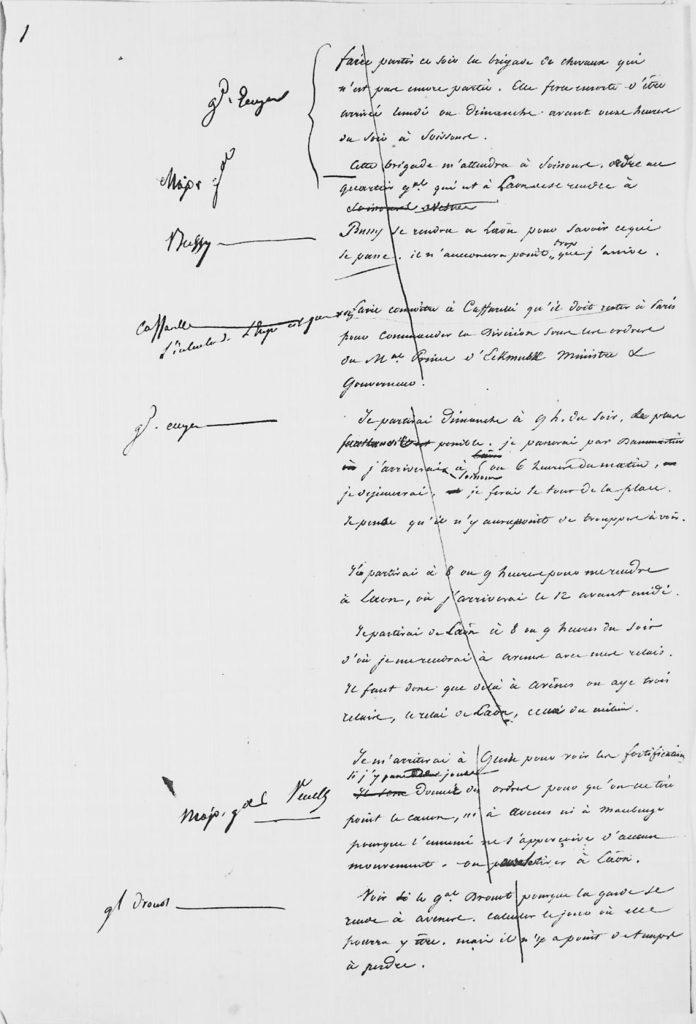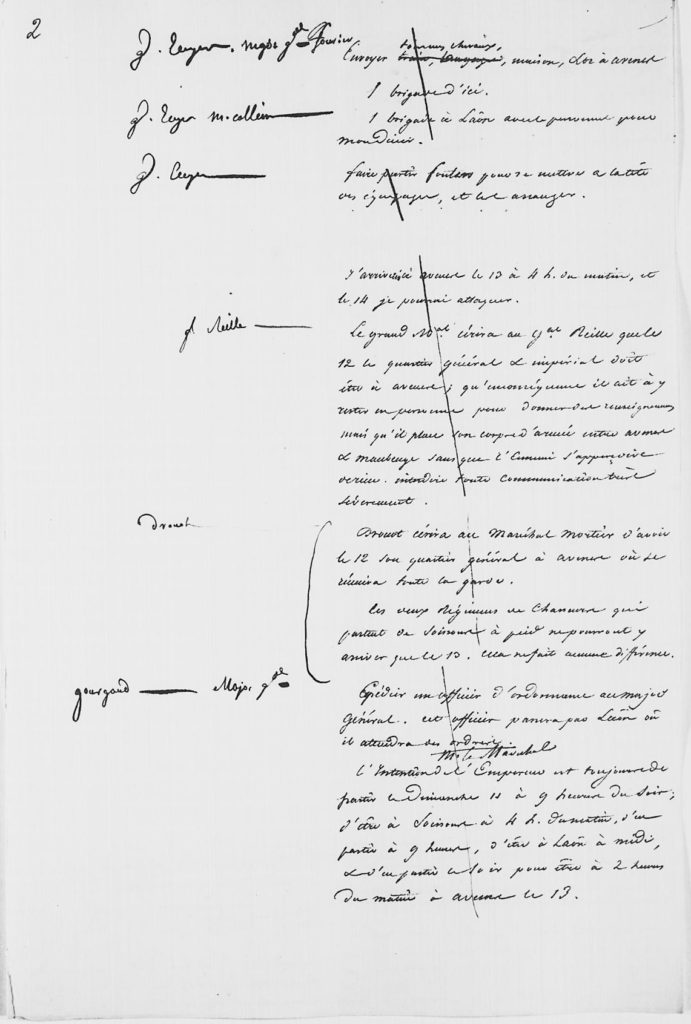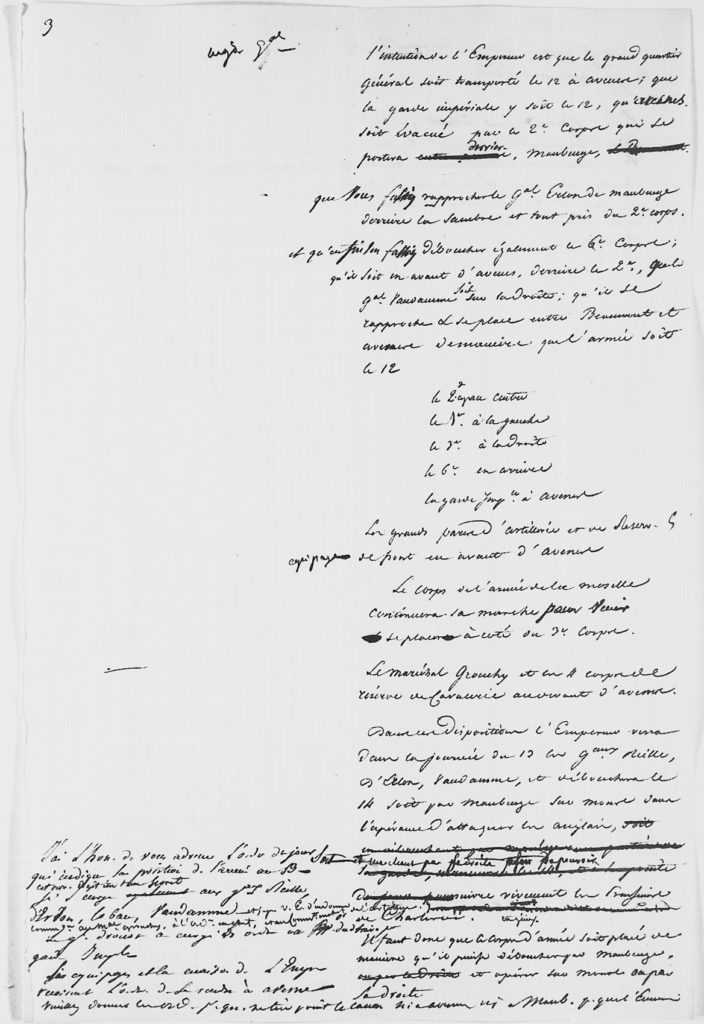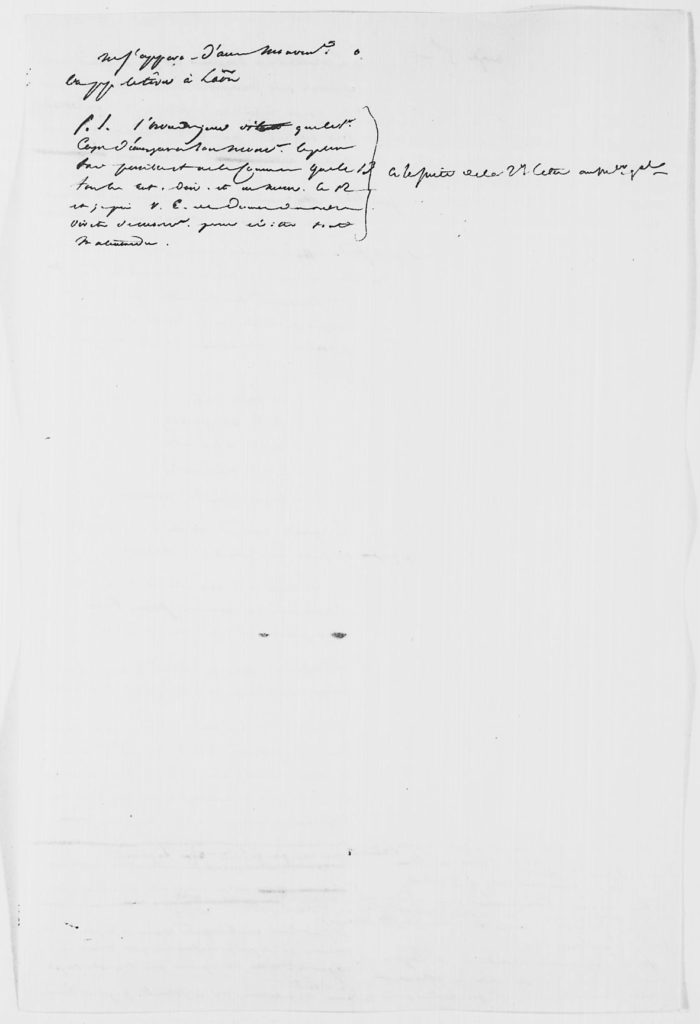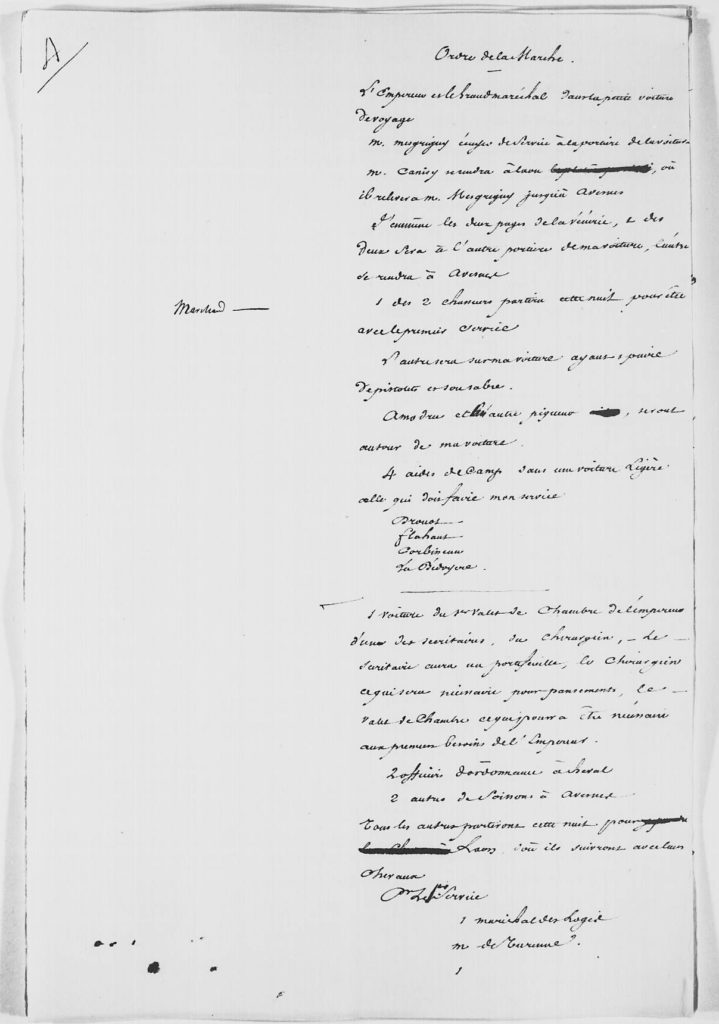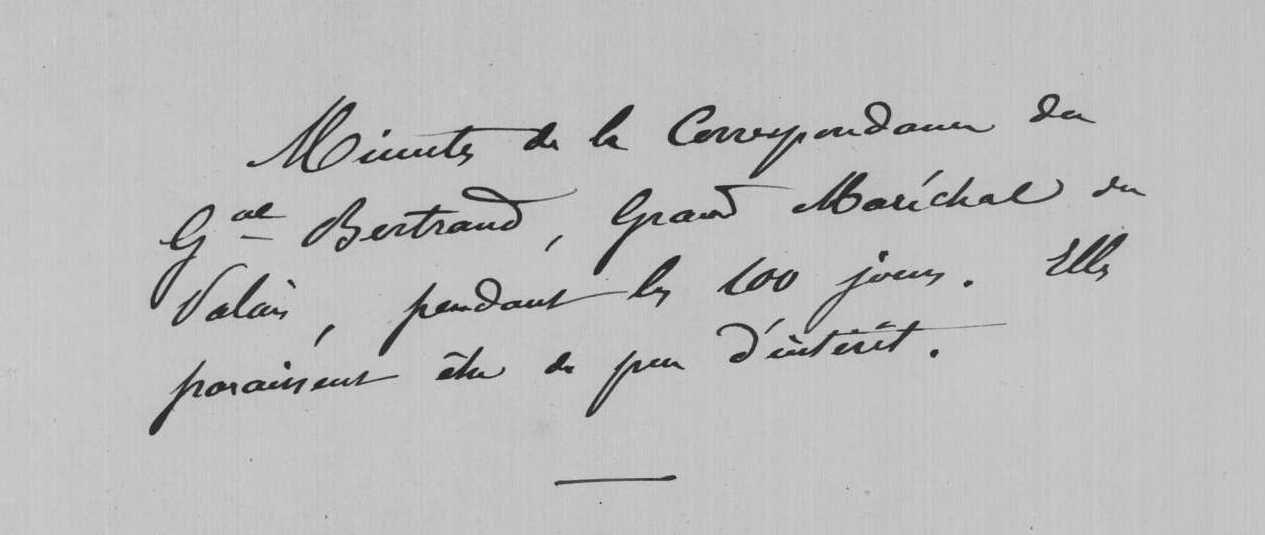
June 10 - Napoleon Dictates
Archives Nationales, 400AP is devoted to Napoleon and his descendants. 400AP/106-400AP109 are the papers of Prince Napoléon. It is there that one finds Papiers du général Bertrand remis par la vicomtesse Henri Bertrand au prince Napoléon en 1881, and it is here that we find Minutes de la Correspondance du Gal Bertrand, Grand Maréchal du Palais, pendant le 100 jours. Elles paraissent être de peu d’intérêt.
Elles paraissent être de peu d’intérêt.
“They seem to be of little interest.”
Let’s take a look anyhow…
This collection includes Bertrand’s registry of correspondence for the cent-jours, as well as what appears to be a collection of notes and at times dictations. Bertrand included his personal correspondence in his registry, so we will focus on what is related to the campaign.
The first registered letter is as follows:
Duplicate
To the Major General by addition
10 June
Although I am sending an officer to Valenciennes. I engage Your Excellency to send a duplicate of the orders that will arrive
perhaps more quickly by the road to Laon.
I pray Your Excellency to share the orders with Gen. Vandamme the orders that I am leaving unsealed.
I also pray you, Marshal, to give orders for movement directly to all the Generals.
This letter was sold at auction March 19, 2008:
To his excellency the Major General
Monsieur le Maréchal,
Although I am sending an officer to Valenciennes, I engage Your Excellency to send a duplicate of the order that will arrive perhaps more quickly by the road to Laon. I pray Your Excellency to share the orders with General Vandamme that I am leaving unsealed.
I request Your Excellency to accept a new assurance of my highest consideration,Le grand maréchal,
Bertrand
The first grouping of notes do not appear as discrete letters, but do appear as dictations:
The Grand Equerry
Major gal
Have the horse brigade that has not yet left leave this evening. It must be sure to arrive in Soissons by Monday or Sunday
before 11 o’clock pm.
This brigade will wait for me in Soissons, order to the General headquarters which is in Laon to go to (Soissons crossed out) AvesnesBussy
Bussy will go to Laon to find out what is happening. He will not announce extensively that I am arriving.
Colonel Bussy was an ADC of Napoleon.
The next dictation indicates that Cafarelli will remain in Paris under Davout’s command.
The next dictation maps out Napoleon’s itinerary, and its content appears in several subsequent letters:
Grand Equerry
I will leave Sunday at 9 o’clock in the evening, as secretly as possible. I will go by way of Dammartin. I will arrive in Soissons at 5 or 6 o’clock in the morning. I will have breakfast, I will make the rounds of the place. I don’t think that there will be any troops to see.
I will leave there at 8 or 9 o’clock to get myself to Laon, where I will arrive on the 12th before noon.
I will leave Laon at 8 or 9 o’clock in the evening from where I will take myself to Avesnes with my relay stations. There must therefore be between there and Avesnes three relay way stations, the post of Laon, those of the middle.
The next appears to be a dictation that again would be inserted into future correspondence:
Major General
I will stop in Guise to see the fortifications if I pass by [during
daylight].
Please give orders that the cannon should not be fired, neither at Avesnes nor at Maubeuge, so that the enemy does not see any movement. We can fire them in Laon.
The above has an important detail – Soult must not allow the cannon to fire in Avesnes nor Maubeuge as to not alert the Allies. But it is ok to fire the cannon in Laon. For Soult to control the cannon in Laon, he would need to receive this order in Laon.
Next, though the Guard has already had orders issued and is on the march, Napoleon indicates a rare sense of urgency in requesting an update:
Gen Drouot
See Gen. Drouot so that the guard takes itself to Avesnes.
Calculate the day which it will be able to be there. But there is no time to lose.
The next three notes all deal with instructions for Napoleon’s departure and journey:
Grand Equerry
Major General – Fouler
Send all of the horses, the household, and gold to Avesnes
1 brigade from here.
1 brigade to Laon with the personnel for my lunch.Grand Equerry
Have Fouler leave in order to be at the head of the staff, and to organize them.
In Fonds Calulaincourt, 95 AP/11, one can find the various notes on Napoleon’s itinerary aggregated into the following letter:
Paris 10 June 1815
Excerpt of Orders from His Majesty
To His Excellency the Grand Equerry
Have the horse brigade that has not yet left leave tonight; it will do the necessary to arrive Sunday or Monday before 11 o’clock pm in Soissons. This Brigade will await me in Soissons.
I will leave Sunday at 9 o’clock pm, as secretly as possible. — I will go by Dammartin; — I will arrive in Soissons at 5 or 6 o’clock in the morning, I will breakfast. I will make a tour of the place. I think there will not be any troops to see.
I will leave at 8 or 9 o’clock to take myself to Laon, where I will arrive the 12th before noon.
I will leave Laon at 8 or 9 o’clock pm, from where I will go to Avesnes with my relays; There must be, therefore, between
there and Avesnes, three way stations; the way station of Laon, those of the middle.Send all of my horses, Maison to Avesnes
1. Brigade from here
1. Brigade to Laon with the personnel for my lunch
Have Fouler leave in order to put himself at the head of the Equipages and organize them.
I will arrive in Avesnes the 13th at 4 o’clock in the morning.
In this itinerary, we see Napoleon planned to leave Sunday, June 11, at 9pm, and arrive in Avesnes, June 13, at 4am. The key to his plan was that with these preparations, he could travel faster than any intelligence of his departure.
The next dictation begins to reveal Napoleon’s plans for the advance:
I will arrive in Avesnes on the 13th at 4 o’clock in the morning, on the 14th I will be able to attack.
Gen. Reille
The Grand Marshal will write to General Reille that on the 12th the Army and imperial headquarters must be in Avesnes; that as a consequence he has to remain there in person to give information but he is to place his army corps between Avesnes and Maubeuge without the enemy perceiving anything. Strictly forbid all communication.
The next dictation deals with the Guard:
Drouot
Drouot will write to Marshal Mortier to have on the 12th his general headquarters in Avesnes where he will assemble all of the guard.
The two regiments of chasseurs that leave Soissons by foot will not be able to arrive until the 13th. That does not make any difference.
At the bottom of page 2, and for the rest of page 3, a detailed disposition for the upcoming campaign is delineated:
Gourgaud – Major Gen
Send an ordonnance officer to the Major General. This officer will pass through Laon where he will await orders.
The first snippet indicates the Gourgaud will send one of his orderlies to Soult. Note that he will stop in Laon.
Mr le Maréchal
The Emperor’s intention is still to leave on Sunday the 11th at 9 o’clock in the evening; to be in Soissons at 4 o’clock in the morning, to leave there at 9 o’clock, to be in Laon at noon, and to leave there in the evening in order to be in Avesnes at 2 o’clock in the morning on the 13th.
The Emperor’s intention is that the Army Headquarters be transported on the 12th to Avesnes; that the imperial guard be there on the 12th, that Avesnes be evacuated by the 2nd corps which will take itself to the rear of Maubeuge, that you have Gen d’Erlon draw closer to Maubeuge behind the Sambre and very near the 2nd corps. And, finally, that you also have the 6th corps advance as well; that it be in front of Avesnes, to the rear of the 2nd, that Gen. Vandamme be on the right; that he approach and place himself between Beaumont and Avesnes in such a way that the army be on the 12th
The 2nd corps in the center
The 1st to the left
The 3rd to the right
The 6th to the rear
The Imperial guard in Avesnes
The large and the reserve artillery parks the bridge crews in front of Avesnes
The corps of the Armée de la Moselle will continue to march in order to come and place itself next to the 3rd corps.
Marshal Grouchy and the 4 reserve cavalry corps in front of Avesnes
In these provisions the Emperor will see during the day of the 13th Generals Reille, d’Erlon, Vandamme, and will end up on the 14th either in Maubeuge to Mons in the hope of attacking the English or by marching by his right in order to be able to follow the Prussians swiftly from Charleroy.
The army corps must therefore be placed so that it in can end up in Maubeuge, and operate on Mons or by its right.
I have the honor of sending you the order of the day which indicates the position of the army on the 13th. This order must be kept secret. I am sending it to General Reille, d’Erlon, Lobau, Vandamme and I pray Your Excellency to communicate it
to Marshal Grouchy, to the ordonnateur en chef and to the commander and chief of artillery.
Gen. Drouot sent orders to Mortier for the Imperial guard.
The equipages and the household of the Emperor are receiving the order to proceed to Avesnes. Please give the orders such
that no canon be fired in Avesnes or in Maubeauge. So that the enemy will not be made aware of any movement. The cannon
may be fired in Laon.P.S. the order of the day says that the 1st army Corps will engage its movement as late as possible and will not begin it until
the 13th. All the others must be in movement on the 12th and I pray Your Excellency to give the orders directly in order to avoid any misunderstandings. } This follows the second letter to the major-general.
While Charleroi is mentioned as a potential target, the army dispositions clearly indicate Mons as the preferred target. 2nd Corps is described as the front, with 1st Corps to the left and 3rd Corps to the right. Nothing prevented switching to Charleroi, but the language in this letter was certainly written from the perspective of an advance on Mons.
The draft does have one problem – the army is given a position for the 12th, but d’Erlon is not supposed to move until the 13th. But, this is a draft, and it turns out the post script is meant for a second letter. Most likely, this will be corrected prior to sending.
Luckily, the original letter survives:
Paris, 10 June 1815,
Monsieur le Maréchal,
The Emperor’s intention is still to leave on Sunday the 11th at 9 o’clock in the evening; to be in Soissons at 4 o’clock in the morning, to leave there at 9 o’clock, to be in Laon at noon, and to leave there in the evening in order to be in Avesnes at 2 o’clock in the morning on the 13th.
The Emperor’s intention is that the Grand General Headquarters be transported on the 12th to Avesnes; that the imperial guard be there on the 12th, that Avesnes be evacuated by the 2nd corps which will take itself to the rear of Maubeuge, that you have Gen d’Erlon draw closer to Maubeuge behind the Sambre and very near the 2nd corps. And, finally, that you also have the 6th corps advance as well; that it be in front of
Avesnes, to the rear of the 2nd, that Gen. Vandamme be on the right; that he approach and place himself between Beaumont and Avesnes in such a way that the army be on the 12th
The 2nd corps in the center
The 1st to the left
The 3rd to the right
The 6th to the rear
The Imperial guard in AvesnesThe grand and reserve artillery parks the bridge crews in front of Avesnes
In these provisions the Emperor will see during the day of the 13th Generals Reille, d’Erlon, Vandamme, and will end up on the 14th either in Maubeuge sur Mons in the hope of attacking the English or by marching by his right in order to be able to follow the Prussians swiftly from Charleroy.
The army corps must therefore be placed so that it in can end up in Maubeuge, and operate on Mons or by its right. I have the honor of sending you the order of the day which indicates the position of the army on the 13th. This order must be kept secret. I am sending it to General Reille, d’Erlon, Lobau, Vandamme and I pray Your Excellency to communicate it to Marshal Grouchy, to the ordonnateur en chef and to the commander and chief of artillery.
Gen. Drouot sent orders to Marshal Duc de Trevise for the Imperial guard.
The equipages and the maison of the Emperor are receiving the order to take themselves to Avesnes.
Please give the orders such that no canon be fired in Avesnes or in Maubeauge. So that the enemy will not be made aware of any movement. The cannon may be fired in Laon.
I beg you, Your Excellency, to accept the assurances of my most sincere consideration.Le grand maréchal,
Bertrand
There are no orders for Gérard, but he is already on the march to Rocroy. The coordination previously spoken of between Vandamme and Gérard apparently no longer relevant. Gérard’s mission may have now been to protect the right and line of communications from a Prussian advance?
And what is the order for the Position of the Army on the 13th? Was it not just given? If this letter was sent on June 10, it is possible d’Erlon could have received it an executed it by the evening of the 12th, but it is cutting it close. And where does Grouchy go – and what of Grouchy’s cavalry? Below one can see the dispositions per the draft instruction, compared to the formal letter:
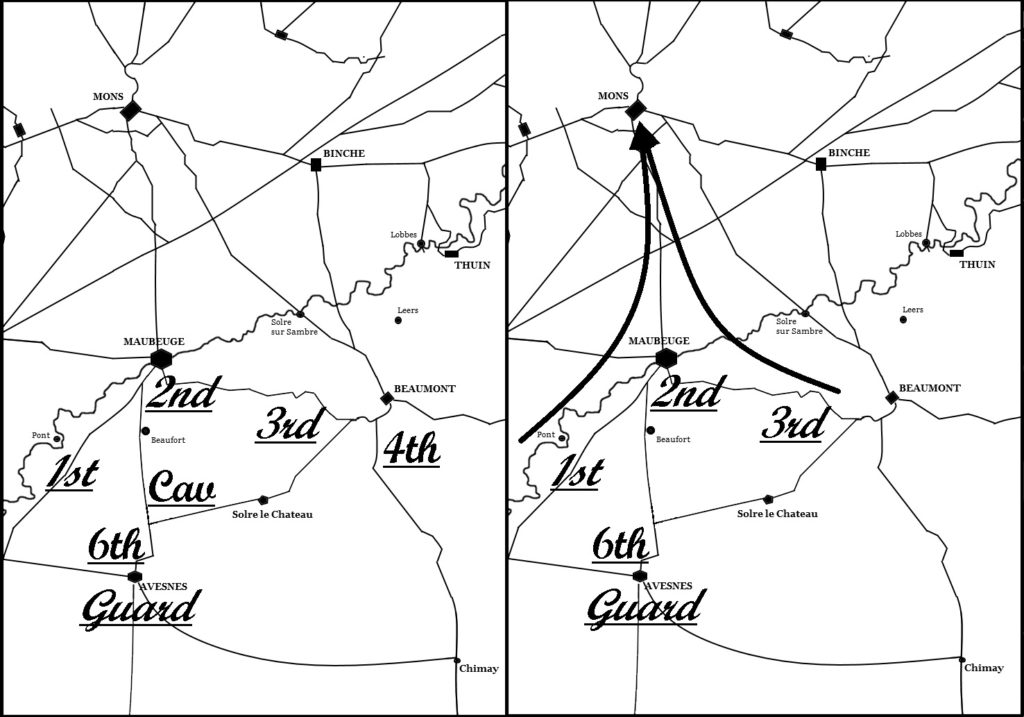
The next note appears to be Bertrand’s draft of the Order of the March. It is almost identical to that found in Fonds Caulaincourt, 95 AP/11, and will not be repeated in full here. But this detail is important, that “There must be relay stations from Avesnes to Maubeuge so that the Emperor can take himself there the 13th itself.”
Nothing was committed, but Napoleon was definitely prepared to launch his advance across the Sambre at Maubeuge. While many have commented on the options of advance and what was best militarily, a direct advance at Wellington had a political opportunity. Defeating Blücher and the Prussians would not threaten the coalition, but defeating Wellington could cause political upheaval Britain. Napoleon may have believed this.
The next note was a draft for the Position of the Army on the 12th:
Order of the army — This order will be sent by the aides de camp to Major General d’Erlon, Reille, Vandamme, Lobau, Marshal Mortier
Position of the army on the 12th
The general headquarters and the 4 divisions of the 2nd corps gathered near and to the rear of Maubeuge.
The 4 divisions of the 1st corps gathered behind the Sambre and to the left of the 2nd corps.
The 3rd corps a little to the rear to the right of the 2nd corps
The 6th corps half way between Avesnes and Maubeuge, straddling the road from Avesnes to Maubeuge, the divisions gathered
The 4 divisions of reserve cavalry of Marshal Grouchy straddling the road from Avesnes to Maubeuge 1 league in front of Avesnes
The army headquarters and the Guard in Avesnes
The bridges crew on the slopes of Avesnes.Armée de la Moselle
All communications along the borders will be intercepted. The soldiers will have 4 days of bread in their packs, 1/2 pound of rice, 50 cartridges, the kitchenware with the divisions. The reserve forces with their army corps. The light cavalry of each army corps will be in front of the corps. Each ambulance at its division.
Each division will have on the auxiliary or military wagons 8 days of biscuit-fired bread and a livestock pen for 2 days.
This order will remain secret and will be sent only to the major General, to the generals d’Erlon, Reille, Vandamme, Comte de Lobau, Grouchy, to the chief supply officer and to the head commander of artillery.
This is consistent with previous orders, including a lack of a destination for Gérard. It is possible that Paris was not fully informed of Gérard’s progress, and thus a decision had not yet been made. Davout had received Gérard’s response to the march orders the day before; is it possible Napoleon was not yet aware?
Regardless, there is another interesting detail of the above position. There is no record of the above order having been sent to anyone. It is not recorded in any registry. There is not a response recorded in Reille’s or d’Erlon’s registry. There is no surviving original document that has ever been seen, outside of the above draft, for this order for the Position of the 12th having been sent to the army.
Considering how much is missing, is this relevant? Consider that the notes end with another Ordre du Jour, the one for the Position of the Army on the 13th that was mentioned in the Bertrand letter above:
Ordre du Jour
Position of the army on the 13th:
Army headquarters and imperial guard to Avesnes.
The artillery parks and bridge crews in front of Avesnes on the slopes.
Reserve Cavalry:
1st and 2nd corps, in Beaumont.
3rd and 4th between Avesnes and Beaumont
6th corps in Beaumont, the general headquarters in the rear.
If the 6th corps should encounter difficulties in getting to
Beaumont, it can stop half-way.
1st corps in Pont-sur-Sambre. This corps will make its movement without passing by Bavay. It will go by way of Le Quesnoy in order to distance itself from the enemy. It will reveal its movement as late as possible as one does not suppose that more than one day will be necessary being in Valenciennes, it will only be the 13th that it will make its movement to arrive at the Sambre.
2nd corps in the rear of Maubeuge in columns on the road to Thuin without crossing the border, and making sure to be seen as little as possible.
3rd corps in Philippeville.
Armée de la Moselle, in Mariembourg
Compared to the previous Bertrand letter, a few things stand out:
- Doesn’t have all the details such as rations carried, cartridges issued, etc.
- Instead of vague positions, the locations are precise
- Gérard’s 4th Corps has a destination
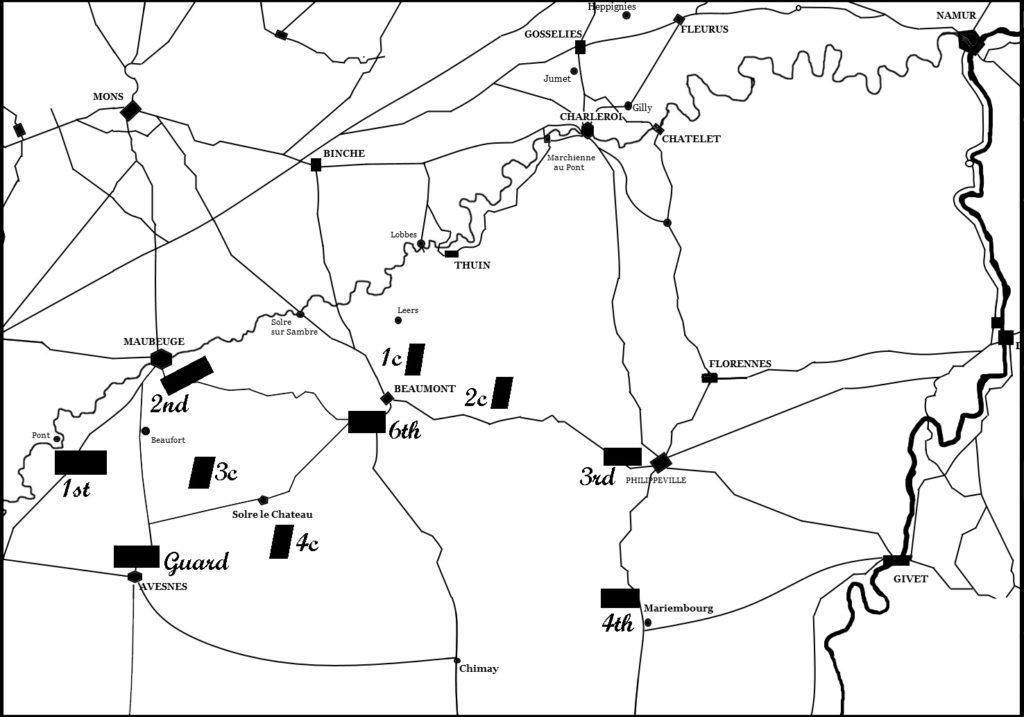
Regnault, in his La Campagne de 1815 – mobilisation et concentration, suggested that one reason Napoleon may have finalized on Charleroi was that Gérard was not going to arrive in time to support an advance via Maubeuge. In this case, if Gérard could not make the party in time, Napoleon could move the advance to Gérard.
One must remember, it is June 10, and it was a feature of every plan that Napoleon would have a day to react.
Having seen the drafts, dictations, and other preparatory actions, we can next examine Bertrand’s registry and the correspondence we know was received.
Below are Bertrand’s notes and drafts from Archives Nationales, 400 AP/109
